Last Updated on July 4, 2025 by Hayk Saakian
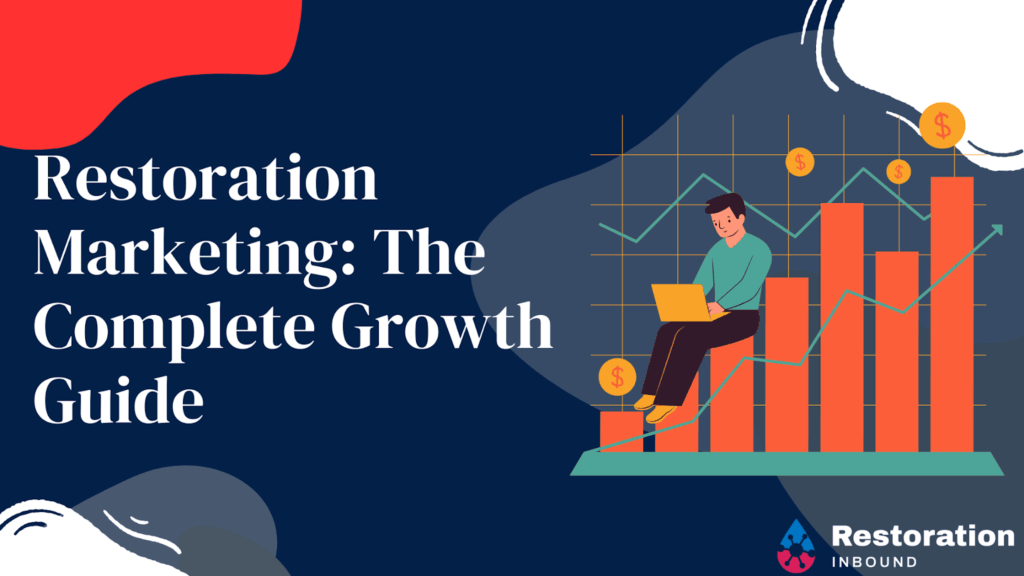
In the dynamic landscape of 2025, the restoration industry is experiencing significant growth, fueled by climate change and aging infrastructure. The global restoration market hit an estimated $50 billion in 2023, with a projected annual growth rate of 4.2% through 2028, according to Gitnux.
However, with growth comes competition. Restoration businesses must now navigate a crowded marketplace where standing out requires more than just quality service: it demands smart, intentional marketing. Effective restoration marketing isn’t optional anymore. It’s the make-or-break gear in your business engine.
And the results speak for themselves. Take Pure Maintenance Arizona. When they came to us, their online presence was nearly nonexistent. Within seven months of focused strategy, they saw:
- 📈 471% increase in website traffic
- 👉 317% more ad clicks
- 💸 34.11% lower cost per click
That kind of transformation doesn’t happen with guesswork. It comes from understanding where your customers are, what they’re looking for, and how to meet them there.
As client Mark Ilyin put it:
“Vlad has a very detailed process that is proven… he puts in great effort to understand the individual needs of his clients. He’s a leader in his field because of his process, professionalism, and well thought out strategies.”
Restoration marketing in 2025 is all about smart technology, hyper-local targeting, and personalized engagement, aligning with the latest restoration industry trends. In fact, digital advertising is projected to account for 73.2% of the $1.08 trillion global ad spend in 2025, showing just how critical it is to get your online strategy right.
In this guide, we’re breaking down everything restoration businesses need to market smarter in 2025. Whether you’re a veteran in the field or just trying to make your first 5-figure month, you’ll find practical, real-world strategies here.
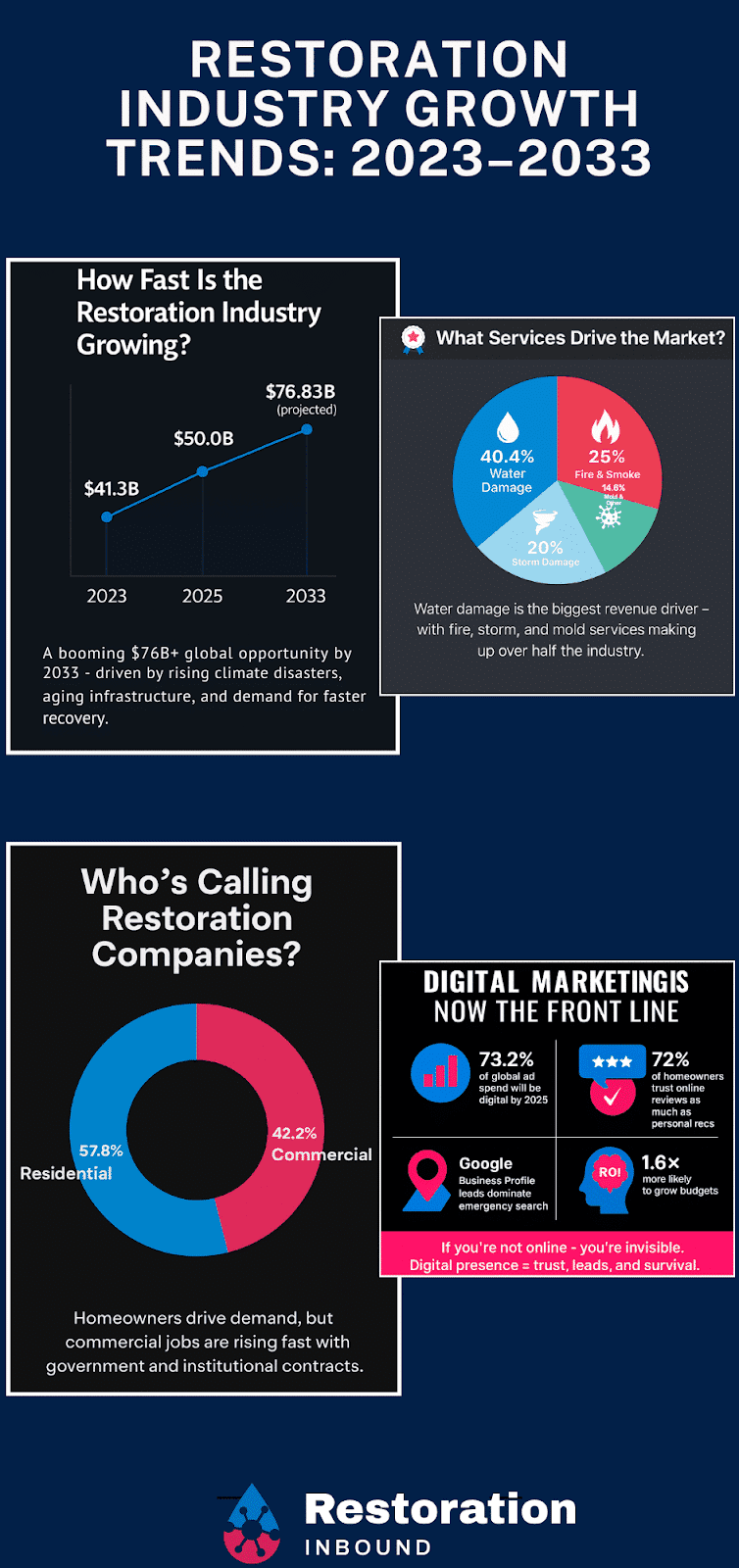
Understanding Restoration Marketing in 2025
What Is Restoration Marketing?
Restoration marketing encompasses the strategies and tactics used by restoration businesses to attract, engage, and retain customers. It involves promoting services such as water damage repair, fire and smoke restoration, mold remediation, and more. The goal is to connect with property owners in need, often during emergencies, and position your company as the trusted solution.
The Evolution Over the Past Decade
A decade ago, restoration companies primarily relied on word-of-mouth referrals, local advertising, and relationships with insurance agents. While these methods still hold value, the digital revolution has transformed the landscape. Today, a strong online presence is crucial. Companies leverage websites, social media, search engine optimization (SEO), and pay-per-click (PPC) advertising to reach potential customers. The shift towards digital channels allows for targeted marketing, real-time engagement, and measurable results.
Key Components of Restoration Marketing in 2025
- Digital Presence: Your website is your front office. It should be fast, clean, and easy to use – think less 2012 and more “we know what we’re doing.” For insights on optimizing your site for lead generation, explore our website development services.” This includes mobile optimization, clear service pages, and features like online booking. Even better if you pair that with a content strategy like our guide on content marketing for restoration companies.
- Customer Engagement: Companies like Next Gear Solutions emphasize the importance of post-job follow-ups, automated communication tools, and personalized customer journeys to increase retention and drive repeat business.
- Service Differentiation: In a competitive market, highlighting what sets your company apart is vital. Whether it’s 24/7 availability, eco-friendly practices, or advanced technology, clearly communicating your unique selling points can influence customer decisions.
Ready to Future Proof Your Restoration Business?
Aligning Marketing with Customer Expectations in 2025
Customers in 2025 expect more and forgive less. They want fast replies, transparent pricing, and businesses that talk like humans, not robots. If your business still doesn’t have an optimized Google Business Profile, you’re already behind. People search online, read reviews, and expect to book service with a couple taps. Make that easy, and you’ve already won half the battle.
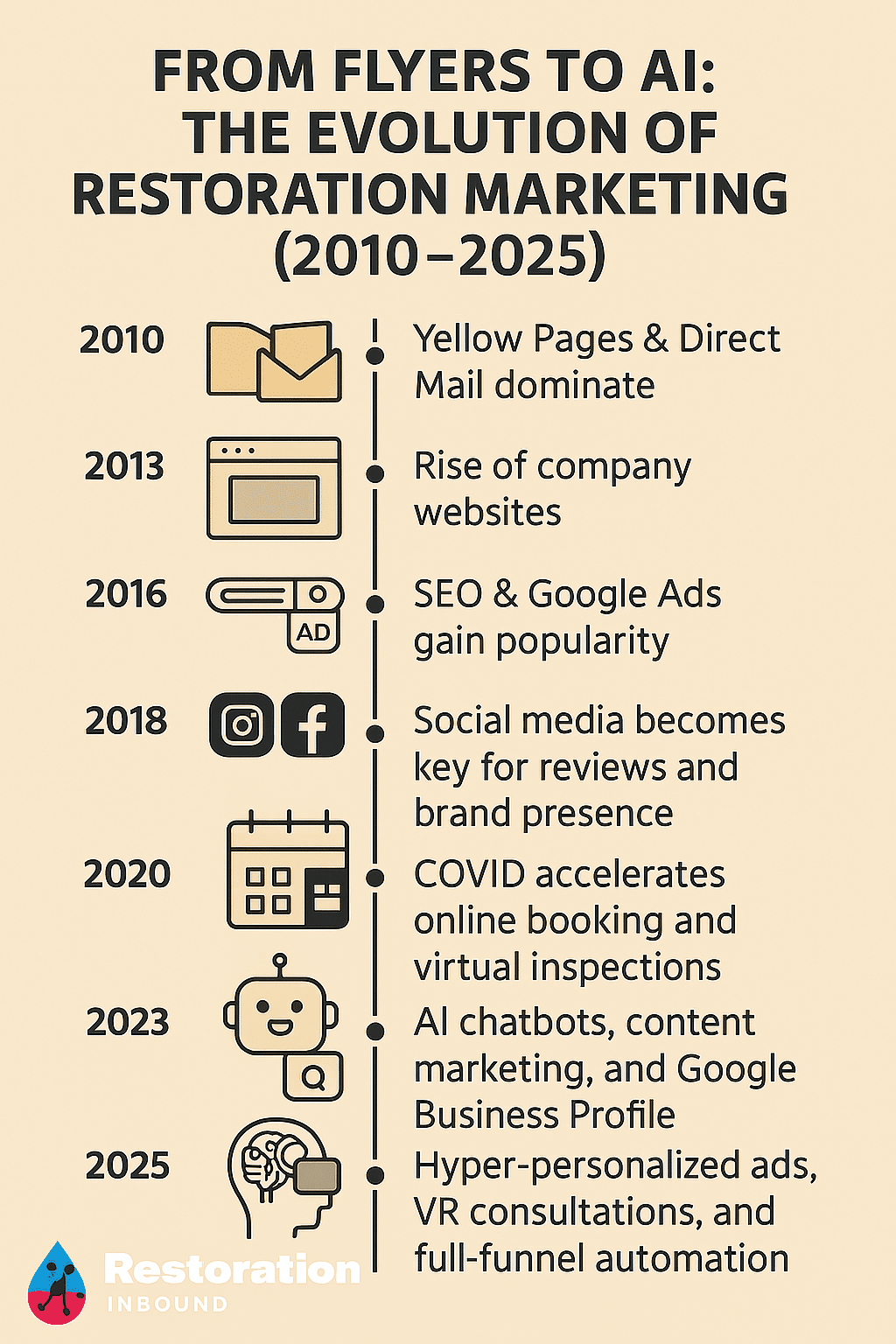
Crafting a Comprehensive Restoration Marketing Plan
Setting Clear Marketing Objectives
Before diving into tactics, it’s essential to define what success looks like for your restoration business. Are you aiming to increase brand awareness, generate more leads, or expand into new service areas? Setting specific, measurable, achievable, relevant, and time-bound (SMART) goals provides direction and a benchmark for success.
Example:
“Increase website traffic by 25% over the next six months through targeted SEO strategies.”
Identifying Target Audiences and Market Segments
Understanding your audience is crucial. Restoration services cater to various groups, including homeowners, property managers, and insurance companies. Segmenting your market allows for tailored messaging that resonates with each group.
Consider:
- Homeowners: Focus on empathy and quick response times.
- Property Managers: Emphasize reliability and ongoing maintenance services.
- Insurance Companies: Highlight compliance and detailed documentation.
Budget Allocation and Resource Planning
Allocating your marketing budget effectively ensures maximum return on investment. Industry experts suggest dedicating 3-9% of your total revenue to marketing efforts, depending on your growth goals. A lower percentage maintains current operations, while a higher investment can drive rapid expansion.For a detailed breakdown, refer to our guide on budgeting for SEO or PPC in restoration marketing.
Selecting Appropriate Marketing Channels
Choosing the right channels to reach your audience is vital. Consider the following:
- Search Engine Optimization (SEO): Enhances online visibility and attracts organic traffic.
- Pay-Per-Click (PPC) Advertising: Drives immediate traffic through targeted ads.
- Social Media: Engages the community and builds brand awareness.
- Email Marketing: Maintains relationships with past clients and nurtures leads.
- Local SEO: Ensures your business appears in local searches, crucial for emergency services.
Establishing KPIs and Performance Metrics
Tracking performance helps assess the effectiveness of your marketing strategies. In fact, companies that consistently measure and optimize ROI are 2.4 times more likely to exceed their financial performance goals, emphasizing the importance of performance tracking.. Key Performance Indicators (KPIs) to monitor include:
- Website Traffic: Measures the number of visitors to your site.
- Conversion Rate: Tracks the percentage of visitors who take desired actions.
- Cost Per Lead (CPL): Calculates the average cost to acquire a lead.
- Customer Lifetime Value (CLV): Estimates the total revenue from a customer over time.
Understanding these metrics allows for data-driven decisions and strategy adjustments.
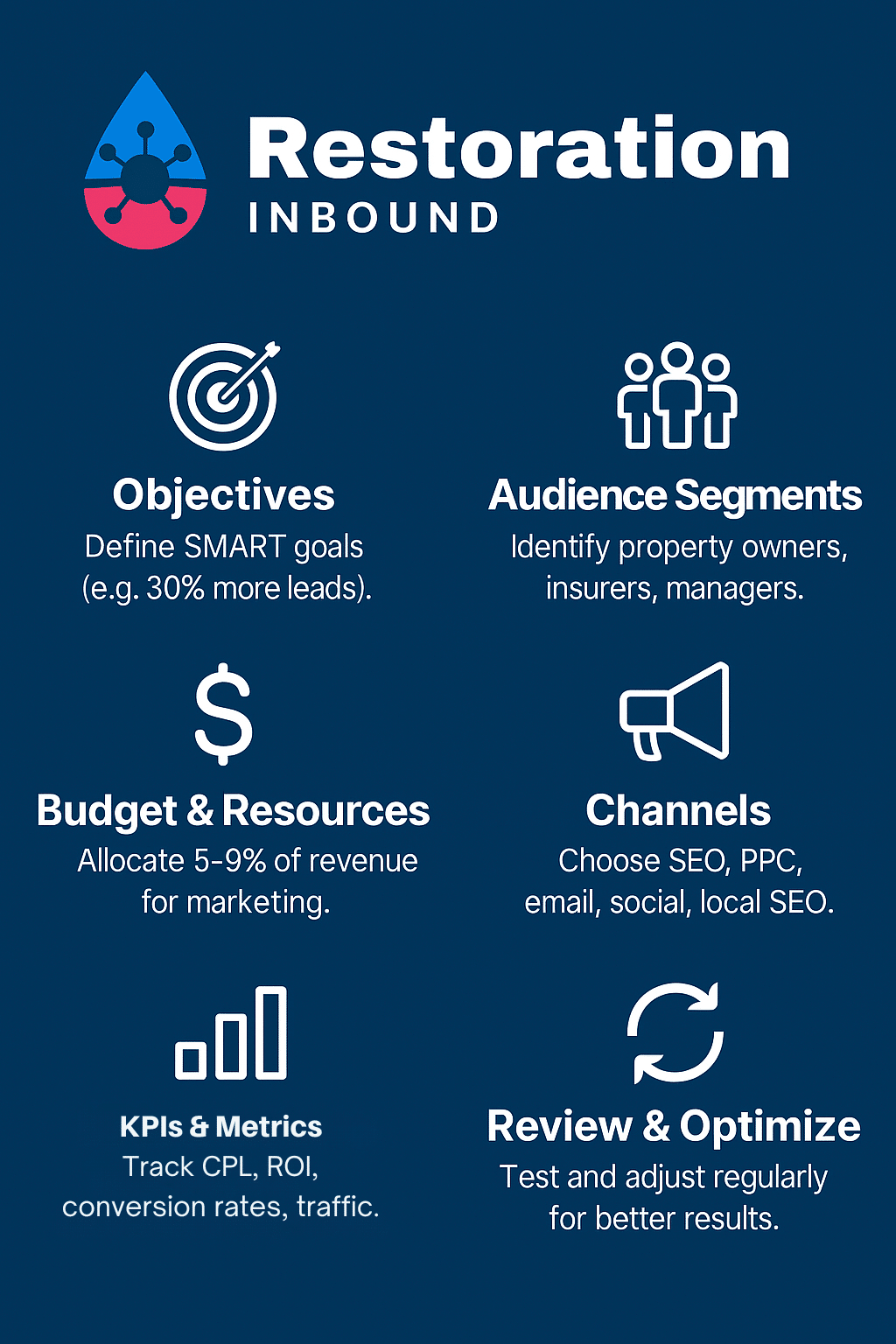
Leveraging Local SEO for Restoration Companies
Why Local SEO Matters
Imagine your neighbor’s basement just flooded. They’re not browsing page five of search results, they’re typing “emergency water cleanup near me” and calling the first business that looks legit. That’s exactly why local SEO for restoration companies is a must-have, not a nice-to-have.You want to show up exactly when someone nearby needs your help, not a day later, not three cities over.
Optimizing Your Google Business Profile (GBP)
Your Google Business Profile is your free, front-row spot in Google’s local listings. If it’s incomplete or outdated, you’re pretty much turning away leads at the digital door.
Here’s what you need to lock down:
- NAP Accuracy: That’s your Name, Address, and Phone Number. No weird typos or mismatches.
- Hours: Keep these current, nothing frustrates a customer faster than calling during your “open hours” and hitting voicemail.
- Photos: Post pictures that make you look professional, not blurry photos of drywall.
- Categories: Choose the right service category, like “Water Damage Restoration.”
- Reviews: The more high-star ratings, the better. Ask for them after every job.
In our experience helping restoration businesses, simply optimizing GBP is one of the easiest ways to increase restoration lead generation in under 30 days.
Local Citations and Directories
Don’t skip the basics. Your business needs to show up consistently across sites like Yelp, Angi, and Yellow Pages. These mentions are called citations, and when your info matches up everywhere, search engines are more likely to trust and rank your business. Consistency builds authority. And authority gets you leads.
Reviews: Your Street Cred in 2025
Let’s face it, nobody believes your website when you say you’re “the best.” They believe Jenny from across town who left a five-star review saying you showed up in 30 minutes and didn’t wreck the carpets. Online reviews are huge. Ask for them. Respond to them. Learn from them. And yes, even respond politely to that one guy who thought you didn’t bring enough fans.
Tip: Text your clients a direct review link while you’re still on-site. That tiny habit can lead to dozens of 5-star reviews over time.
Location-Specific Landing Pages
If your restoration company serves multiple cities or counties, one homepage isn’t enough. Create individual landing pages for each service area. These should include:
- Services tailored to that location
- Local client testimonials
- Neighborhood-specific keywords (“water damage repair in Peachtree City”)
- Easy contact options like a local phone number
This makes it easier for Google to match you to the right local search and helps customers feel like you’re right around the corner, not three counties away.
Ready to Stop Guessing and Start Growing?
Innovative Restoration Marketing Ideas for 2025
Marketing in 2025 isn’t just flyers and Facebook ads anymore. Customers are smarter, expectations are higher, and frankly, they’re tired of being “sold to.” If you want your restoration business to stand out, you’ve got to get creative and a little bold. Here are some restoration marketing ideas that’ll actually make people remember your name (for the right reasons).
Virtual Consultations with a Side of Tech Magic
Remember when Zoom calls felt futuristic? Now they’re just… expected. In 2025, restoration companies can use tech like virtual reality (VR) and AI tools to make consultations faster, easier, and more impressive. Offer a quick video walk-through using a phone camera so clients can show you damage before you drive across town. Use a virtual model to walk them through what repairs would look like. It’s not “techy,” it’s just smart and people love seeing that you’re ahead of the game.
And let’s be real: if you can impress someone before even showing up, you’ve probably already won the job.
Host Real-World Stuff That Isn’t Boring
Digital marketing is great, but real-life connections still matter, especially in tight-knit communities. Set up community workshops about topics people actually care about.
Think “How to protect your home from basement flooding this spring” or “What to do right after a fire.” No PowerPoints. Just helpful info, snacks, and friendly advice. Bring a few before-and-after photos from past jobs (you know the ones), hand out a magnet, and you’re in business. We’ve seen restoration pros turn one local event into five leads, just by showing up and being human. Want more inspiration? Our social media marketing for restoration companies post dives into how to turn event content into ongoing engagement.
Reward People for Sending Work Your Way
You’d be surprised how many people would recommend you, if you just asked. Set up a referral program.
Make it simple: “Send us a job, get a $50 gift card.” Or maybe a free inspection for every three referrals. Whatever works for your audience. The key is making it clear, easy, and worth their while. Take it a step further with loyalty programs for property managers or real estate agents. If they keep calling you, reward that loyalty, even if it’s just coffee or branded gear. You’re building relationships, not just sending invoices.
Make People Like You (Seriously)
Cause marketing isn’t just about looking good, it’s about doing good. And in 2025, customers are paying attention. Sponsor a local youth team, run a winter coat drive, or donate time and services to someone in need after a local disaster.
This kind of community service builds trust, earns local media coverage, and gives you something real to share online (besides another air scrubber photo). And hey, it feels good too.
Bonus Idea: Bring the Humor
We all know restoration work can be rough. So lighten it up in your content. Share behind-the-scenes moments (the good, the messy, and the funny). Post silly “Guess that damage” games on your socials. Let people see the humans behind the logo. People trust brands that aren’t afraid to be a little real, especially when their house is a mess and they’re stressed.
Measuring and Analyzing Marketing Performance
If you’re not measuring your efforts, you’re guessing. And in marketing, guessing is expensive. Let’s walk through how to track whether your restoration marketing strategies are pulling their weight or just burning through your budget.
The KPIs You Actually Need to Watch
Not every number is important. You don’t need to obsess over bounce rates or how many people clicked on that one blog post about “the science of drywall.”
Focus on these instead:
- Leads generated: How many new potential customers called, filled out your form, or requested a quote?
- Conversion rate: Out of those leads, how many turned into real jobs?
- Cost per lead: Are you spending $20 or $200 to get someone to call you?
- Return on investment (ROI): If you spent $1,000 on ads and booked $5,000 in work, well… you’re doing just fine. For a deeper understanding, here’s how to calculate the ROI of a marketing campaign.
- Organic traffic growth: Especially from Google searches. That’s a sign your restoration SEO is doing its job.
If you want to go deeper, we cover these in our guide to conversion optimization for restoration websites. But honestly, even just tracking those 4 – 5 things will already put you ahead of 90% of your competition.
What Tools Should You Use?
Here’s the good news: you don’t need a NASA control room to track your numbers. Start with these:
- Google Analytics: Great for tracking who visits your website, how they got there, and what they did.
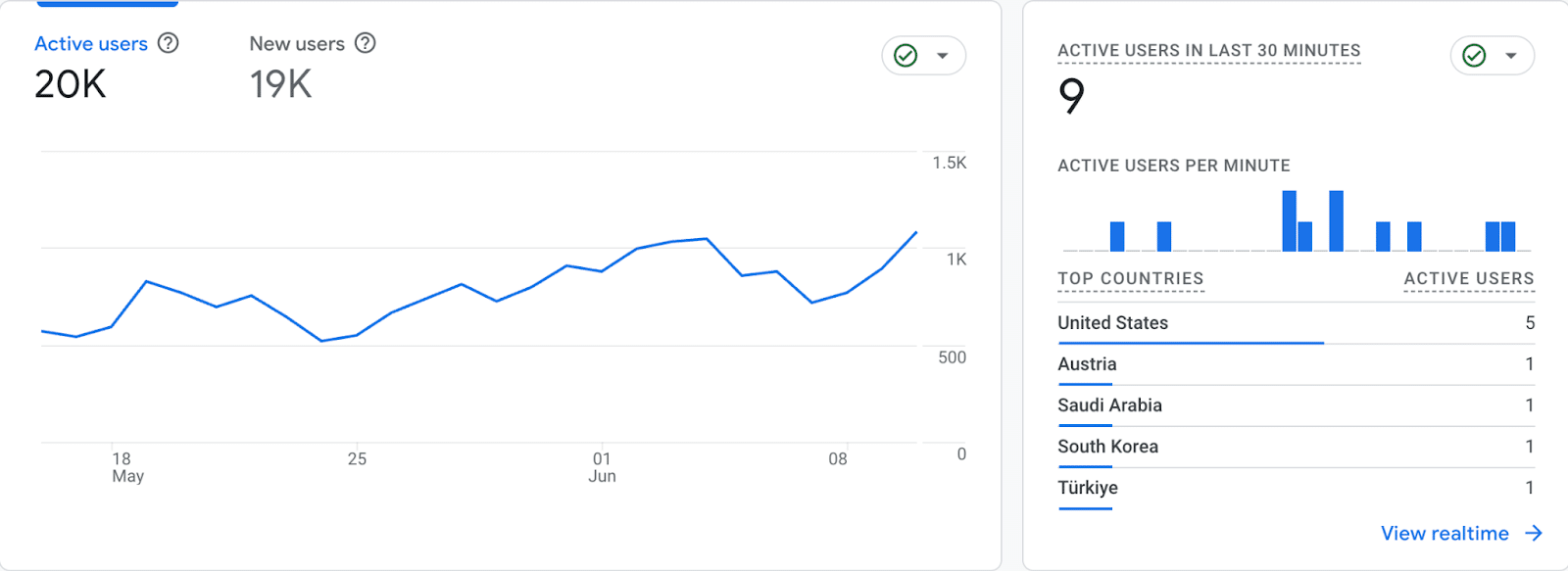
- Call tracking software: So you know which ads or web pages are sending calls your way.
- CRM or job management software: Helps you log leads, see close rates, and stay organized.
- Google Business Profile insights: Tells you how many people are finding you on local search and maps.
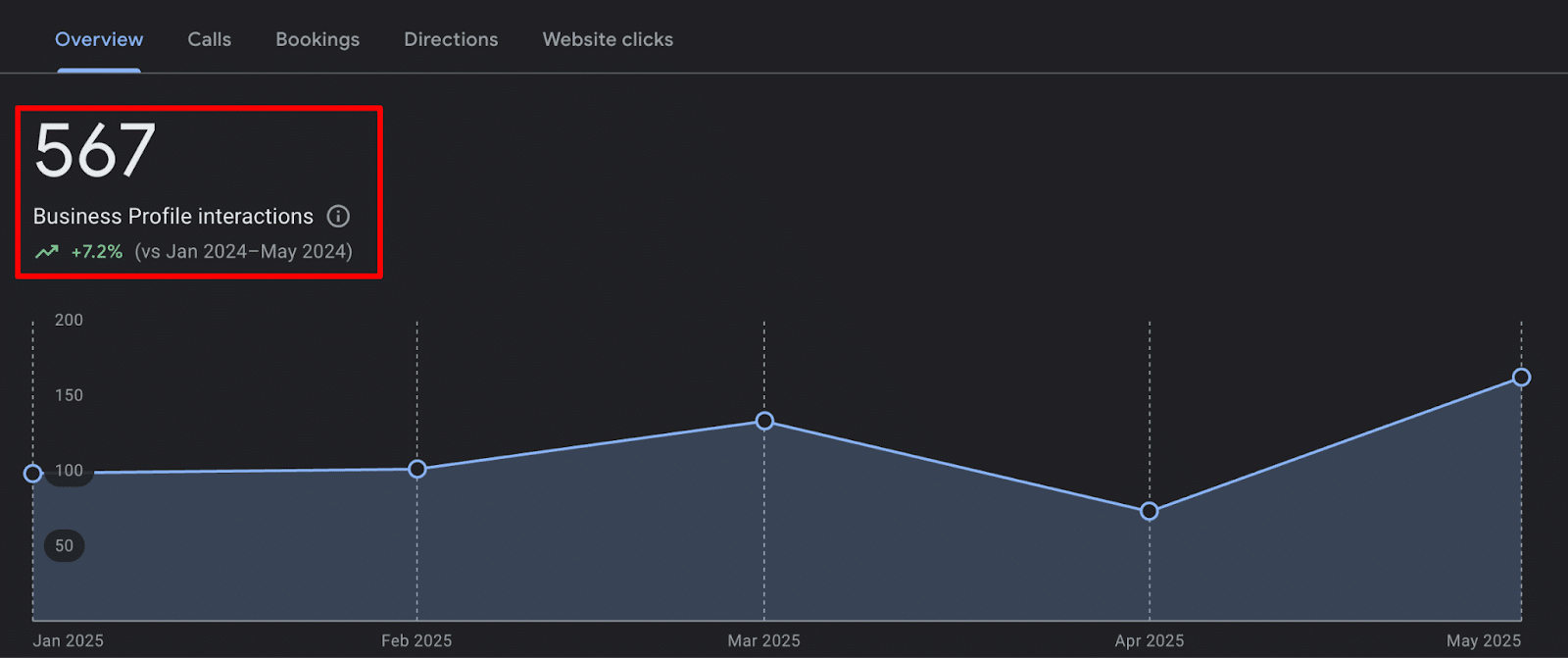
If numbers aren’t your thing, no shame. Use dashboards. Most tools give you graphs and charts now, so you can spot patterns without needing a calculator.
A Real Example That Proves It Works
We worked with a restoration company last year that was spending big on ads and getting zero jobs from it. Painful. After a quick audit, we noticed their landing page had no form, the phone number wasn’t clickable, and the headline said “Restoring Comfort” (whatever that means). We helped them rework the landing page with clearer messaging, better call-to-actions, and a form that worked.
In 30 days, lead conversions jumped 3x with the same ad spend. It wasn’t magic. It was just measurement + smart edits = results.
Want to See What’s Working in Real Restoration Campaigns?
Frequently Asked Questions
1. What is restoration marketing?
Restoration marketing helps businesses get found by people needing cleanup services after water, fire, or mold damage. It includes SEO, ads, reviews, and content that brings in leads.
2. Why is digital marketing crucial for restoration businesses in 2025?
Customers search online first. Digital marketing helps you show up when they need fast help. It builds trust, generates leads, and keeps your business competitive.
3. How does local SEO benefit restoration companies?
Local SEO gets your business found in map results when people search nearby. An optimized Google Business Profile and local reviews improve your visibility and lead generation.
4. What are effective lead generation strategies for restoration services?
PPC ads, content marketing, and social media work best. Referral programs and strong reviews also drive steady restoration lead generation.
5. How can I measure the success of my restoration marketing efforts?
Track leads, conversion rates, cost per lead, and ROI. Tools like Google Analytics and call tracking help you monitor results.
6. Should I hire a restoration marketing agency or manage marketing in-house?
Agencies bring expertise and save time. In-house can work if you have marketing knowledge and consistency. Our guide on choosing a restoration SEO agency breaks it down.
If you’ve made it this far, first of all, hats off. You clearly care about growing your restoration business the smart way. We’ve covered everything from building a solid restoration marketing strategy to diving deep into local SEO, and tracking your results. This isn’t fluff. It’s the same approach we use every day to help companies just like yours turn clicks into calls and calls into booked jobs.
The biggest takeaway? Marketing isn’t one big magic trick. It’s a system, built with clear goals, consistent effort, and a few clever plays to stay ahead of the competition (especially in 2025, when AI is rewriting the rules by the hour). Pick one tactic and start today.
And hey, if you’d rather have pros handle it for you? We’ve helped restoration companies across the U.S. grow their traffic, leads, and revenue.
We’re here to help. No pressure. Just results.